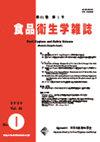肢端藻副鼻藿有毒成分的分离及其化合物的同时分析。
IF 0.2
4区 农林科学
Q4 FOOD SCIENCE & TECHNOLOGY
引用次数: 1
摘要
建立了肢端藻副叶柄藻有毒成分丙烯酸A、丙烯酸B和丙烯酸啶的分离方法。采用硅胶、ODS、离子交换柱层析和制备层析等方法对香菇提取物进行了高纯度的纯化。利用这些结果,我们优化了LC-MS/MS条件。最后,我们提出了一种同时分析的方法。加样回收率为80.8 ~ 112.4%,重复性为1.4 ~ 3.8 rsd %。各化合物的定量限为0.25 μg/g。根据实验结果,该方法可以揭示由肢端藻副喙藻引起的食物中毒的原因。本文章由计算机程序翻译,如有差异,请以英文原文为准。
[Isolating Venomous Constituents of Paralepistopsis acromelalgaand Simultaneous Analysis of Its Compounds].
An isolation method for Acromelic acids A, B and Clitidine, which are venomous constituents of Paralepistopsis acromelalga was developed. Highly purified products were obtained from the mushroom extract using silica gel, ODS, ion-exchange column chromatography and preparative TLC. Using those results, we optimized the LC-MS/MS conditions. Finally we developed a method for simultaneous analysis. In recovery tests, the average recovery was 80.8-112.4%, repeatability was 1.4-3.8RSD%. The limits of quantification of the respective compounds were estimated as 0.25 μg/g. Based on the results, this method can reveal causes of food poisoning by Paralepistopsis acromelalga.
求助全文
通过发布文献求助,成功后即可免费获取论文全文。
去求助
来源期刊

Food Hygiene and Safety Science
Medicine-Public Health, Environmental and Occupational Health
CiteScore
0.70
自引率
0.00%
发文量
28
审稿时长
18-36 weeks
期刊介绍:
Information not localized
 求助内容:
求助内容: 应助结果提醒方式:
应助结果提醒方式:


